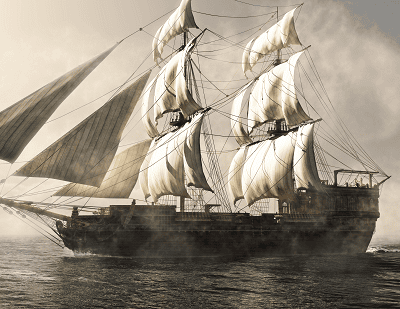Sailing the high seas is an adventure that many sailors relish. The sense of freedom, the beauty of the open water, and the thrill of exploration are some of the reasons why sailing is an enduring pastime. However, sailing also has its share of risks and dangers. Pirates and looters, for instance, can pose a significant threat to sailors and their vessels. This article aims to provide practical tips and advice on how sailors can protect themselves from piracy and looting while sailing. The thesis of this article is that sailboat security measures can be implemented to protect against piracy and looting. The article will begin with an overview of the potential dangers of piracy and looting and then discuss the various security measures that sailors can take to protect their vessels.
Understanding the Risks and Threats
Types of piracy and looting: Pirates and looters can use various tactics to attack vessels. Armed robbery is a common tactic where pirates use guns or other weapons to threaten sailors and loot their vessels. Theft is another tactic where pirates steal valuable items such as electronics, cash, and jewellery. Vandalism is also a common tactic where pirates destroy or damage the vessel. Kidnapping is a rare but possible tactic where pirates abduct sailors for ransom or other purposes.
Identifying high-risk areas: Some areas are known to be hotspots for piracy and looting. The Gulf of Aden, the Strait of Malacca, and the waters off the coast of Somalia are some of the areas where pirates are known to operate. Sailors should avoid these areas if possible or take extra precautions if they have to sail through them.
Evaluating personal risk factors: Sailors should assess their personal risk factors before sailing. Factors such as the type of vessel, the value of the cargo, and the number of crew members can make a vessel more attractive to pirates. Sailors should also consider their sailing experience, knowledge of the area, and other factors that can increase their vulnerability to piracy and looting.
Implementing Sailboat Security Measures
Physical security measures: Sailors can install physical security measures such as locks, alarms, and surveillance systems to protect their vessels. Locks can be installed on doors and hatches to prevent unauthorized entry. Alarms can be installed to alert sailors of any intrusions or unauthorized movements of the vessel. Surveillance systems such as CCTV cameras can also be installed to monitor the vessel and its surroundings.
Crew training: Sailors should develop protocols for responding to threats and emergencies. Crew members should be trained on how to recognize potential threats, how to respond to emergencies, and how to use safety equipment such as life rafts and distress signals.
Communication and monitoring: Sailors should stay informed about weather conditions and potential threats. They should also maintain regular communication with other vessels and authorities such as coast guards and naval patrols. This can help them to receive early warning of any potential threats and to seek assistance if necessary.
Dealing with Piracy and Looting
 Prevention: The best way to deal with piracy and looting is to prevent them from happening in the first place. Sailors should avoid high-risk areas if possible and take preventative measures such as installing locks, alarms, and surveillance systems. They should also maintain a low profile and avoid advertising their wealth or valuables.
Prevention: The best way to deal with piracy and looting is to prevent them from happening in the first place. Sailors should avoid high-risk areas if possible and take preventative measures such as installing locks, alarms, and surveillance systems. They should also maintain a low profile and avoid advertising their wealth or valuables.
Response: If an attack or intrusion does occur, sailors should respond quickly and calmly. They should follow their protocols for responding to emergencies and use any safety equipment or weapons they have available. They should also communicate with other vessels and authorities for assistance.
Recovery: After an attack or intrusion, sailors should deal with the damage, losses, and psychological trauma. They should document any damage or losses and report them to the relevant authorities. They should also seek medical attention if necessary and address any psychological trauma caused by the incident. It's essential to seek professional help if needed, as psychological trauma can have long-lasting effects on a person's mental health.
Legal and Ethical Considerations
Laws and regulations: Sailors must navigate international laws and local regulations when sailing in different countries. Different countries have different laws and regulations on the use of force, self-defence, and the possession of weapons. Sailors must familiarize themselves with these laws and regulations before sailing in those countries to avoid legal problems.
Ethical considerations: Sailors must balance their right to self-defence with human rights and cultural sensitivity. The use of force, even in self-defence, can have serious consequences, both legal and ethical. Sailors must consider the potential consequences of their actions and the impact they may have on the local community.
Conclusion
In conclusion, sailboat security measures are crucial for protecting sailors and their vessels from piracy and looting. Sailors must understand the risks and threats of piracy and looting and take necessary precautions to protect themselves and their vessels. Physical security measures such as locks, alarms, and surveillance systems can help prevent piracy and looting. Crew training and communication can also help sailors respond to threats and emergencies effectively. In case of an attack or intrusion, sailors must respond quickly and calmly and seek assistance from authorities. Lastly, sailors must navigate legal and ethical considerations when sailing in different countries to avoid legal problems and cultural conflicts. By staying informed and prepared, sailors can enjoy the freedom and adventure of sailing while staying safe and secure.
Hashtags: #sailboatsecurity #piracyprevention #sailingadventures #safetyatsea #protectingvessels #legalconsiderations #ethicalconsiderations
